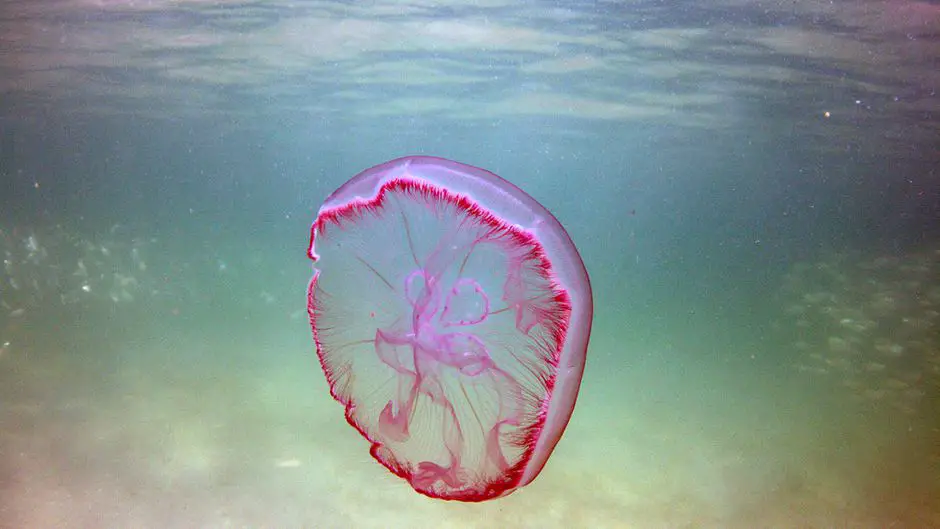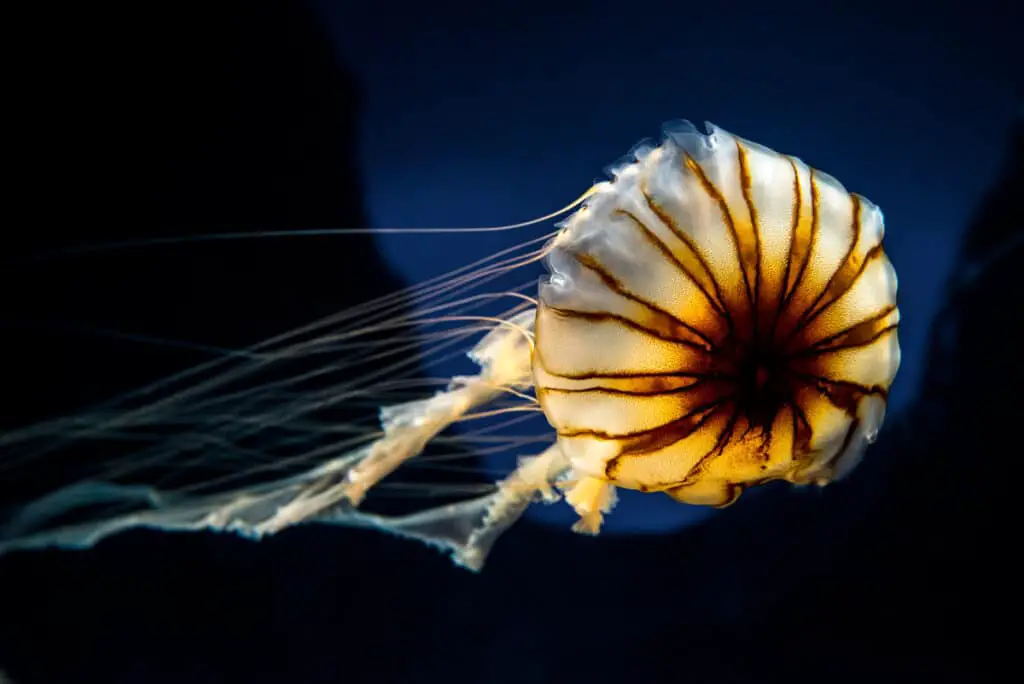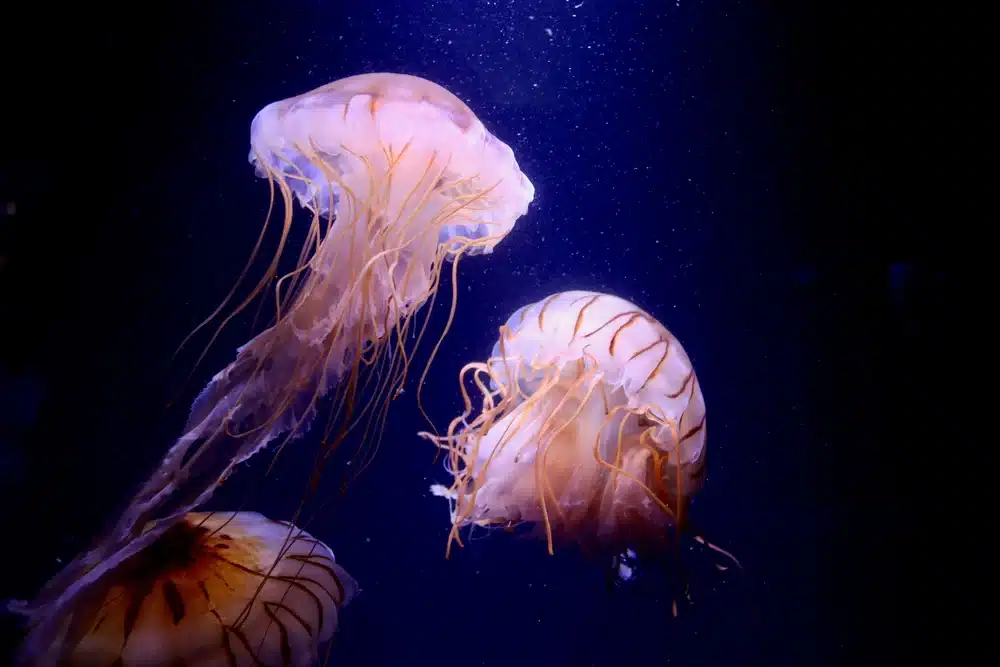Can Jellyfish Live In Freshwater

Introduction
Can Jellyfish Live In Freshwater: Jellyfish are captivating creatures that have long fascinated marine biologists and enthusiasts alike. These gelatinous, translucent organisms are primarily associated with the ocean’s vast depths, where they gracefully drift with the currents.
Jellyfish are considered marine inhabitants, perfectly adapted to the saltwater conditions of oceans and seas. Their unique physiology, which includes specialized cells called cnidocytes that deliver venomous stings to capture prey, appears tailored to the challenges of the marine ecosystem. Their reliance on saltwater for osmoregulation, the process of maintaining proper water balance in their bodies, further emphasizes their marine preference.
Nature often surprises us with its adaptability and resilience. Over the years, reports and studies have emerged suggesting that some jellyfish species might have the capacity to tolerate and even thrive in freshwater habitats. This intriguing possibility has sparked scientific curiosity and debates about the limits of jellyfish adaptability and the factors influencing their survival beyond the ocean’s confines.
We delve into the enigmatic world of jellyfish and their potential ability to inhabit freshwater environments. We examine the scientific evidence, environmental factors, and physiological adaptations that shed light on this intriguing question, ultimately revealing the remarkable adaptability of these captivating creatures.

Do jellyfish live in freshwater or saltwater?
Jellies can live in freshwater
It’s well known that jellies thrive in the open ocean and in brackish water. But zero salt content in their water? That’s not a problem for some jellies. The tiny freshwater jellyfish (Craspedacusta sowerbii), for example, is native to China’s Yangtze River Basin.
Jellyfish primarily inhabit saltwater environments, such as oceans, seas, and coastal waters. Their physiology and osmoregulation mechanisms are well-suited to the high salinity levels found in these marine habitats. However, the question of whether jellyfish can live in freshwater has intrigued scientists and naturalists.
Some jellyfish species have demonstrated an unexpected ability to adapt to lower salinity conditions. The freshwater jellyfish, Craspedacusta sowerbii, is a notable example. It can thrive in lakes, ponds, and other freshwater bodies, challenging the notion that all jellyfish are exclusively marine creatures.
Despite these intriguing exceptions, it’s important to note that the majority of jellyfish species remain firmly associated with saltwater ecosystems. Their specialized stinging cells and osmoregulatory processes have evolved to suit the challenges and opportunities presented by marine environments. While some jellyfish may temporarily venture into brackish or even freshwater habitats, they are the exception rather than the rule.
What would happen if a jellyfish was placed in freshwater?
Since jellyfish live in saltwater climates, placing them in a freshwater lake could kill them. They are used to waters with a high concentration of solutes, but a freshwater lake has a much lower concentration of solute particles due to the lack of salt in the water.
If a jellyfish were placed in freshwater, it would likely face significant challenges and potential harm to its health. Jellyfish are highly adapted to the saltwater conditions of marine environments, and a sudden transfer to freshwater can disrupt their delicate physiological balance.
The key issue lies in osmoregulation, the process by which jellyfish maintain proper water balance within their bodies. In saltwater, jellyfish have a higher salt concentration inside their cells compared to the surrounding environment. This enables them to absorb water through osmosis and maintain their structural integrity.
The specialized stinging cells, called cnidocytes, that jellyfish use for predation and defense rely on salt ions to function properly. In freshwater, the altered ion concentrations could impair the effectiveness of these stinging cells.
Ultimately, placing a jellyfish in freshwater would likely cause stress and damage to its cellular structure, impacting its overall health and survival. For these reasons, it is generally advisable to keep jellyfish in their natural saltwater habitats and to exercise caution when attempting to transfer them to freshwater environments.
Do jellyfish have to live in saltwater?
They prefer a warm environment and often live near coastlines in the Atlantic, Pacific, and Indian oceans. These organisms can live in saltwater or brackish (mixed salt- and freshwater) environments, and waters between 45- and 70-degrees Fahrenheit offer them the best chance of survival.
Jellyfish are predominantly associated with saltwater environments, and their physiology is finely tuned to thrive in these conditions. The majority of jellyfish species are adapted to life in oceans, seas, and coastal waters. This adaptation includes specialized mechanisms for osmoregulation, which allows them to maintain the appropriate balance of salt and water within their bodies.
In saltwater, jellyfish have evolved to have a higher salt concentration inside their cells compared to the surrounding ocean water. This difference in salt concentration allows them to absorb water through osmosis and maintain their structural integrity. Additionally, the stinging cells (cnidocytes) that jellyfish use for capturing prey and defending against predators are optimized for saltwater conditions, as they rely on specific ion concentrations to function effectively.
While some jellyfish species, such as the freshwater jellyfish Craspedacusta sowerbii, have demonstrated an ability to adapt to lower salinity environments, they are exceptions rather than the norm. Most jellyfish species are not well-equipped to live in freshwater, and abrupt transitions to such environments can be detrimental to their health.
While there are exceptions, the vast majority of jellyfish are best suited to life in saltwater, where they have evolved and adapted to thrive in the challenging conditions of the world’s oceans and seas.
Can jellyfish live in still water?
Freshwater jellyfish prefer still water without a current, so they are most common in ponds, lakes, quarries and backwaters, and they also are most prevalent in good, clean water, Ordinary reports. If the water source dries up, they can go dormant until the environment is wet again.
Jellyfish are incredibly adaptable creatures, but their ability to thrive in still water depends on several factors, including their species, size, and specific environmental conditions.
Some jellyfish species are better suited to still or calm waters, such as lakes and ponds, as opposed to the turbulent ocean. For example, the freshwater jellyfish, Craspedacusta sowerbii, often resides in stagnant or slow-moving bodies of freshwater. However, even in still water, these jellyfish require proper conditions to survive, including suitable temperatures, food sources, and water quality.
In contrast, many marine jellyfish species are more commonly found in the open ocean, where they can drift with ocean currents. These species may struggle to survive in completely still water, as they rely on currents for transportation, dispersal of their offspring, and access to prey.
Overall, the ability of jellyfish to live in still water varies among species, and their survival in such environments depends on the specific adaptations they possess. While some jellyfish can indeed thrive in still water, others are better suited to dynamic marine ecosystems where currents and tides play a crucial role in their life cycle.
What happens if you touch a jellyfish?
The long tentacles trailing from the jellyfish can inject venom from thousands of microscopic barbed stingers. Most often jellyfish stings cause instant pain and inflamed marks on the skin. Some stings may cause more whole-body (systemic) illness. And in rare cases they’re life-threatening.
Touching a jellyfish can lead to a painful and sometimes dangerous encounter, depending on the species. Many jellyfish possess specialized stinging cells called cnidocytes that contain venomous structures called nematocysts. When a jellyfish comes into contact with an object or a person, these nematocysts can discharge venom.
The effects of a jellyfish sting can vary in severity, ranging from mild discomfort to life-threatening reactions. Common symptoms include pain, itching, redness, and welts at the site of contact. In more severe cases, stings from certain species, like the box jellyfish or Portuguese man-of-war, can lead to intense pain, muscle cramps, nausea, vomiting, difficulty breathing, and in extreme cases, cardiac arrest or death.
The appropriate response to a jellyfish sting depends on the severity and the specific species involved. Immediate actions often include rinsing the affected area with saltwater (not freshwater, as it can exacerbate the situation), using vinegar to neutralize nematocysts, and applying heat to alleviate pain. Seeking medical attention is crucial for severe stings.
To minimize the risk of jellyfish stings, it’s essential to exercise caution when swimming in areas known for jellyfish presence and to wear protective clothing like wetsuits or rash guards. Understanding the local marine life and heeding warning signs and lifeguard advice can also help prevent potentially painful encounters with these intriguing but potentially dangerous creatures.
How are freshwater jellyfish different from marine jellyfish?
Freshwater jellyfish and marine jellyfish are distinct in several ways, primarily due to the different environments they inhabit:
Habitat: The most obvious difference is their habitat. Freshwater jellyfish, like Craspedacusta sowerbii, live in freshwater ecosystems such as lakes, ponds, and slow-moving rivers, while marine jellyfish are found in saltwater environments like oceans, seas, and coastal waters.
Size: Freshwater jellyfish are typically smaller than their marine counterparts. They usually measure around 1 to 2 inches in diameter, while some marine jellyfish can grow much larger, with tentacles extending several feet.
Salinity Tolerance: Freshwater jellyfish have adapted to lower salinity levels in their environment, whereas marine jellyfish are well-equipped to handle the high salt concentrations of seawater. This difference in osmoregulation mechanisms allows freshwater jellyfish to thrive in freshwater conditions.
Life Cycle: The life cycles of freshwater and marine jellyfish can also differ. Some freshwater jellyfish undergo asexual reproduction by budding, while marine jellyfish typically reproduce sexually, releasing eggs and sperm into the water.
Predatory Behavior: Both types of jellyfish possess stinging cells (cnidocytes), but the specific mechanisms and potency of their venom can vary. Marine jellyfish may have more potent stinging cells to capture prey and defend against predators in their competitive oceanic environment.
How can I identify freshwater jellyfish in the wild?
Identifying freshwater jellyfish in the wild can be a fascinating but challenging endeavor. These delicate, translucent creatures are not as commonly encountered as their marine counterparts, making them a unique discovery for nature enthusiasts. To spot them, look for slow-moving or stagnant bodies of freshwater, such as ponds, lakes, or slow-moving rivers, particularly during the warmer months when they are more active.
Freshwater jellyfish are typically small, about the size of a quarter, with a bell-shaped, transparent body. Their most distinctive feature is the presence of delicate, hair-like tentacles that hang down from the edge of the bell. These tentacles are used to capture tiny aquatic organisms, their primary source of food.
When trying to identify freshwater jellyfish, observe their pulsating, rhythmic movement. Like marine jellyfish, they propel themselves by contracting their bell-shaped bodies, creating a gentle pulsing motion. However, their coloration can be quite variable, ranging from a pale translucent hue to a more opaque white or even greenish tint, depending on their diet and environmental conditions.
Remember that freshwater jellyfish are not harmful to humans, so observing them in their natural habitat can be a rewarding experience for those who appreciate the wonders of aquatic ecosystems. Always exercise caution and respect for the environment while observing these unique creatures in the wild.
Are there any conservation efforts to protect freshwater jellyfish?
Conservation efforts for freshwater jellyfish are relatively limited compared to other endangered or vulnerable species, mainly because they are not considered a critical keystone species in most ecosystems. However, there is a growing awareness of their ecological importance and the need to protect these unique creatures.
Some regions and organisations have taken steps to conserve freshwater jellyfish populations. These efforts primarily involve studying their habitats, behavior, and life cycles to gain a better understanding of their needs and vulnerabilities. Conservationists and researchers are also monitoring environmental factors such as water quality, temperature, and habitat degradation to assess their impact on freshwater jellyfish populations.
Public education plays a crucial role in promoting the conservation of freshwater jellyfish. Raising awareness about the importance of preserving all aquatic life, regardless of its size or prominence, can lead to greater public support and interest in protecting these delicate creatures. Citizen science projects, where volunteers help monitor freshwater ecosystems, can contribute valuable data on jellyfish populations and distribution.
While freshwater jellyfish may not be the primary focus of conservation efforts, they are a part of the broader effort to protect freshwater ecosystems. These efforts aim to safeguard the biodiversity and health of these habitats, benefiting not only jellyfish but also countless other species that depend on these aquatic environments.

Conclusion
While traditionally considered inhabitants of marine environments, evidence suggests that some jellyfish species do indeed exhibit a surprising degree of adaptability to freshwater conditions. Studies have revealed that certain jellyfish species, such as the freshwater jellyfish Craspedacusta sowerbii, can thrive in lakes, ponds, and other freshwater bodies.
Their ability to adapt to lower salinity levels challenges our preconceived notions about their habitat preferences. These findings highlight the remarkable plasticity of jellyfish, enabling them to adjust their osmoregulatory processes to suit different environmental conditions.
However, the ability of jellyfish to live in freshwater is not uniform across all species. While some can make the transition successfully, many others remain exclusively marine. This diversity underscores the complexity of these creatures and the role that evolution and ecological factors play in shaping their adaptability.
While jellyfish primarily inhabit saltwater environments, the possibility of their existence in freshwater ecosystems is a fascinating testament to nature’s adaptability. Understanding the mechanisms behind their freshwater survival can offer valuable insights into their biology and the ever-changing dynamics of aquatic ecosystems. Further research is needed to unravel the intricacies of jellyfish adaptability and its broader implications for ecology and conservation efforts.



